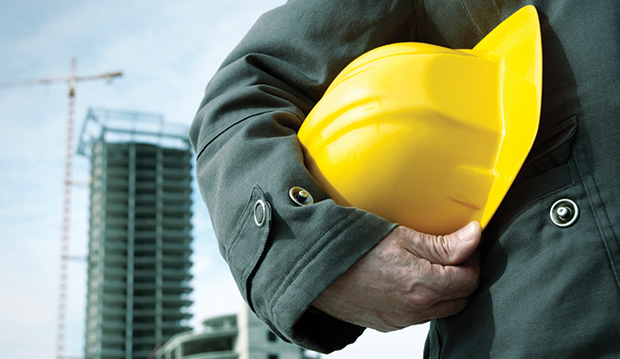Be aware of what’s on OSHA’s radar
By: DOLAN MEDIA NEWSWIRES//July 30, 2014//

By Jeffrey Clark, Scott Prill
and Carolyn Sullivan
 An unfortunate side effect of the improved economy and rise in work has been a noted increase in fatality and injury rates in the construction industry, according to David Michaels with the Occupational Safety and Health Administration.
An unfortunate side effect of the improved economy and rise in work has been a noted increase in fatality and injury rates in the construction industry, according to David Michaels with the Occupational Safety and Health Administration.
As a result, OSHA is keeping a close eye on several areas of construction, in particular.
Temporary workers
Temporary laborers include those working under a host employer or in a staffing agency employment structure. According to OSHA, 3 million temporaries are in the nation’s workforce today and “[a]t least 14 temporary workers have died during their first day at a new worksite in the past 12 months,” as noted in a June 26, 2013 article in Business Insurance magazine.
OSHA suspects some employers use temporary workers to skirt the agency’s employee safety training, chemical hazard communication and on-the-job injury and illness recordkeeping requirements. Therefore, an April 29, 2013, OSHA memorandum directed its field inspectors to assess whether employers who use temporary workers comply with applicable OSHA requirements.
During inspections, OSHA’s compliance officers determine whether temporary workers have received the safety training and protection that the agency requires for the particular job. For example, OSHA inspectors might focus on whether temporary workers are trained in a language and vocabulary they understand.
According to OSHA, “[s]taffing agencies and their client employers who host temporary workers share the legal obligations to provide workplaces free of recognized hazards.”
In other words, OSHA believes employers and staffing agencies are jointly responsible for the safety of their temporary workers.
A construction employer’s OSHA-related responsibilities include:
- training employees to the particular workplace equipment and hazards;
- communicating with the staffing agency at the beginning of the engagement to set out their respective responsibilities for compliance with applicable OSHA standards;
- recording on the job injuries and illnesses, if the employer supervises the workers on a day to day basis; and
- treating temporary workers like any other employee in terms of safety and health protection.
A construction staffing agency’s OSHA-related responsibilities include:
- training in general safety and health;
- assessing the conditions of the workplace;
- ensuring that the workplace is safe; and
- determining what hazards may be encountered in the workplace and how best to protect temporary workers.
Fall protection
Three of the top 10 recent common OSHA violations, according to the agency’s website, are related to working from heights. Additionally, about one third of construction fatalities result from on the job falls. This fatality percentage does not even include all the occupational injuries related to falls. Hence, OSHA has prioritized fall prevention as one of its enforcement priorities.
The agency has issued guidelines, fact sheets and videos regarding fall protection. OSHA’s fall protection campaign consists of three elements:
- plan ahead to help employees safely do the job;
- provide the workers with the right equipment; and
- train employees to use the equipment safely.
The agency also is partnering with others to create an outreach program to raise industry awareness about hazards from construction related falls. To stay on top of this high-risk area, construction employers and their workers should focus on fall prevention, including ladder, scaffolding and roof-working safety, and related topics.
Silica
Another key concern of OSHA is silica, because exposure to the material is on the rise as power equipment is used more frequently in construction, according to a June 12 story at safety.blr.com.
OSHA has been working to establish a more stringent permissible exposure limit for silica in the air, though at this time those efforts are on hold. However, some reduction in OSHA’s PEL for silica is likely, especially as the material may come more into focus with the frac sand mining operations underway in western Wisconsin and other areas of the country.
Cranes and derricks
OSHA is targeting cranes and derricks with two regulatory measures.
After receiving a number of critical comments about its crane standard, OSHA recently focused on operator qualifications. An agency standard now requires construction crane operators to meet one of four qualifications/certifications by Nov. 10 of this year. Until that date, employers must ensure that operators are competent to safely operate a crane.
But it appears enforcement of that standard will be pushed back three years, as proposed by OSHA earlier this year, to allow the industry more time to react. The proposal also would extend to November 2017 the existing phase-in requirement that employers ensure that their operators are qualified to operate the equipment, according to a Feb. 7 OSHA news release.
OSHA also is proposing corrections and amendments to its final standard for cranes and derricks. The standard contains provisions designed to improve crane safety and to reduce worker fatality and injury rates. OSHA’s proposed provisions would clarify the use of demarcated boundaries for working near electrical power lines and correct an error allowing body belts to be used as a personal fall-arrest system.
Other areas likely to draw increased OSHA attention in the years to come include: confined spaces, back-over fatalities and injuries, and on the job injury and illness reporting. The construction industry should be prepared to address these potential areas of concern, not only to comply with applicable regulations, but also to provide a safe working environment for all construction employees, both temporary and permanent.
Jeffrey Clark is a shareholder in Reinhart Boerner Van Deuren SC’s litigation, labor and employment law, real estate, and environmental law practices. He can be reached at 414-298-8131 or [email protected].
Scott Prill works as a consultant for Reinhart attorneys. He can be reached at 414-298-8212 or [email protected].
Carolyn Sullivan is an attorney in the firm’s environmental, litigation and real estate practices. She can be reached at 262-951-4536 or [email protected].
Legal News
- History made in Trump New York trial opening statements
- Prosecutor won’t bring charges against Wisconsin lawmaker over fundraising scheme
- Republican Wisconsin Senate candidate says he doesn’t oppose elderly people voting
- Vice President Harris to reveal final rules mandating minimum standards for nursing home staffing
- Election workers fear threats to their safety as November nears
- Former law enforcement praise state’s response brief in Steven Avery case
- Eric Toney announces re-election bid for Fond du Lac County District Attorney
- Former Wisconsin Democratic Rep. Peter Barca announces new bid for Congress
- Republicans file lawsuit challenging Evers’s partial vetoes to literacy bill
- More human remains believed those of missing woman wash up on Milwaukee Co. beach
- Vice President Harris returning to Wisconsin for third visit this year
- Wisconsin joins Feds, dozens of states to hold airlines accountable for bad behavior
WLJ People
- Power 30 Personal Injury Attorneys – Russell Nicolet
- Power 30 Personal Injury Attorneys – Benjamin Nicolet
- Power 30 Personal Injury Attorneys – Dustin T. Woehl
- Power 30 Personal Injury Attorneys – Katherine Metzger
- Power 30 Personal Injury Attorneys – Joseph Ryan
- Power 30 Personal Injury Attorneys – James M. Ryan
- Power 30 Personal Injury Attorneys – Dana Wachs
- Power 30 Personal Injury Attorneys – Mark L. Thomsen
- Power 30 Personal Injury Attorneys – Matthew Lein
- Power 30 Personal Injury Attorneys – Jeffrey A. Pitman
- Power 30 Personal Injury Attorneys – William Pemberton
- Power 30 Personal Injury Attorneys – Howard S. Sicula








